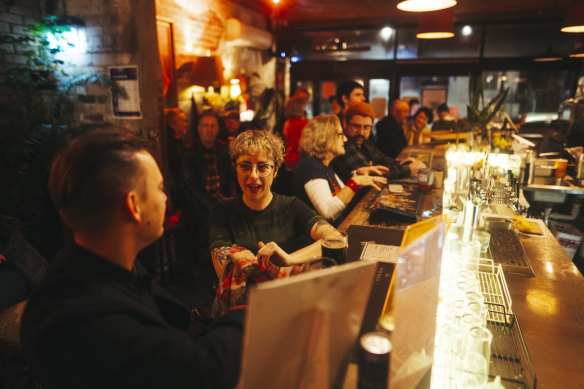This was published 7 months ago
Saturday night fever: Sydney’s changing party habits revealed
Could Sydney’s sleepy nightlife finally be waking up? So it seems, based on Opal and credit card data that shows Saturday nights overtaking Thursdays as the time to be out in the city.
While Thursday became the new Friday when working from home became the norm for many people post-pandemic, Saturday nights are back, especially in the CBD, eastern suburbs and inner west.

Saturday nights are back after Thursdays took over as the most popular night out.Credit: Dion Georgopoulos
People are not just wining and dining. Sports and physical recreation activities such as going to the gym have also grown, as has consumption of takeaway food, while liquor retailing and gambling have recorded declines in their share of the night-time economy.
The Office of the 24-Hour Economy Commissioner’s latest night-time economy quarterly report for NSW reveals there were 35.7 million Opal tap-offs at night, an increase of 4.4 per cent year-on-year.
“Weekday night-time public transport usage continues to be driven by commuters, with higher overall trips on weeknights,” the report says. “The increased night-time usage share on weekends demonstrates more trips for leisure and social activities.”
In the three months to June 30, the report also found spending in person on Saturday night eclipsed Thursday night ($50.8 million v $46.7 million). In the March quarter, Thursday night had recorded the most spending at night.
The research found that the NSW night-time economy is worth $102 billion a year, employing one-fifth of all workers, and supports more than 53,000 core businesses, including music venues, restaurants, bars and leisure-activity providers.
However, the research shows the effect of the cost-of-living crunch, with night-time spending falling to $3.57 billion in the second quarter of this year, a 10 per cent drop from the previous quarter.
The Minns government will on Wednesday unveil Data After Dark, a new platform that will track growth and changes in economic activity across the state between 6pm and 6am.
Data After Dark will use multiple information sources, including Opal travel data and spending transactions, to create a baseline to track the impact of the government’s so-called vibrancy laws.
The vibrancy laws include tearing up “no entertainment” clauses, restrictions on what genres of music venues can play, as well as stopping single neighbour noise complaints from shutting down pubs and other licensed venues.
The government has also ended the outdated rule that prevented people living within five kilometres of a registered club from signing in without first becoming a member.
Minister for Music and the Night-time Economy John Graham said a strong nightlife was critical to a global city such as Sydney.
“The insights that Data After Dark provides will help business and government understand this part of the economy better, and make the most informed, data-led decisions on how to grow its contribution,” Graham said.
“The platform leverages a wealth of information on night-time trading, safety and mobility to tailor policy like never before.”
Start the day with a summary of the day’s most important and interesting stories, analysis and insights. Sign up for our Morning Edition newsletter.